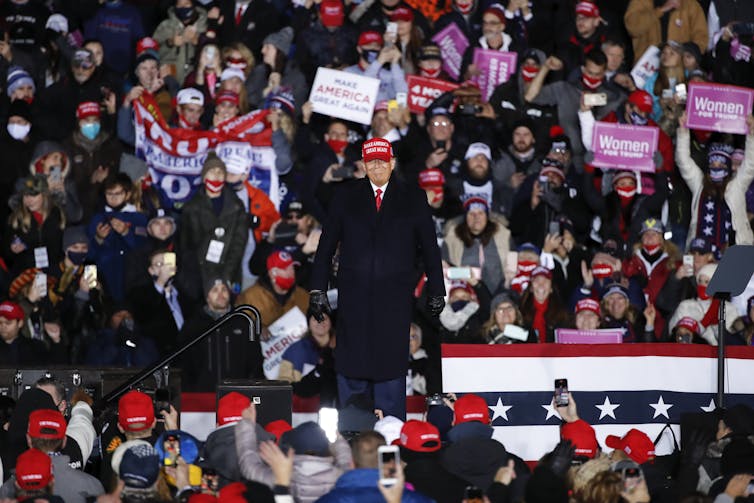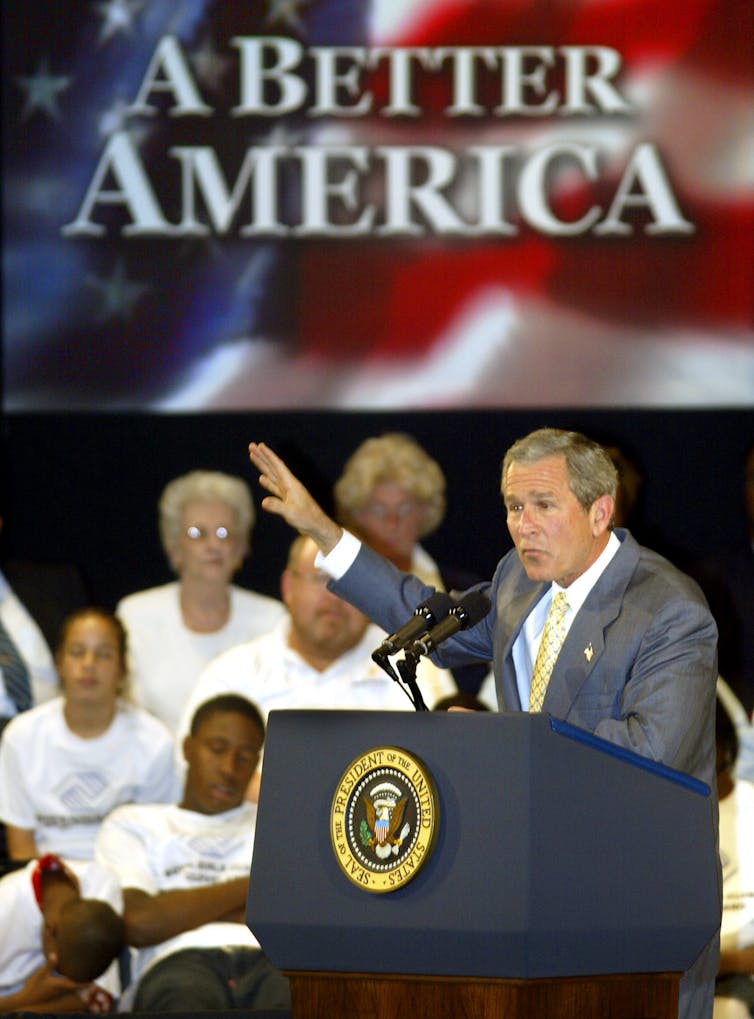A less Trumpy version of Trumpism might be the future of the Republican Party
- Written by Morgan Marietta, Associate Professor of Political Science, University of Massachusetts Lowell
Donald Trump lost the 2020 election, but his populist ideas may continue to animate the Republican Party.
As scholars of American beliefs and elections[1], we can envision a less Trumpy version of Trumpism holding sway over the party in coming years. We call it “polished populism.”
Populism is folk-politics[2] based on the premise that ordinary citizens are wiser and more virtuous than supposedly corrupt and self-serving elites[3]. Populist rhetoric[4] is often expressed in cruder, coarser language than ordinary political speech – less like a politician on a stage and more like a guy in a bar[5].
Trump, a prime practitioner of populist rhetoric, took this to an extreme[6] with the shorthand of Twitter and the insults[7] of the locker room.
Polished populists take a different approach, arguing for the same policies[8] that Trump did – limiting immigration[9], redistributing wealth toward the working class[10] rather than just the poor, opposing the woke policies of social justice movements[11], promoting “America First” foreign and trade policies[12] – but without his overtly antagonistic language.
Some Republicans[13] are now arguing for a rejection of populism and a return to traditional conservatism[14]. Those long-standing GOP priorities[15] include limited government, strong national defense of American interests abroad, religious values and, perhaps most importantly, ordinary political personalities.
For two reasons – the GOP’s narrow electoral defeat in 2020[16] and the changing demographics of the Republican Party[17] – we believe that populist policies, if not rhetoric, will continue to be a dominant theme of the Republican Party.
 President Donald Trump smiles after speaking during an election rally on Nov. 3, 2020, in Grand Rapids, Mich.
Kamil Krzaczynski/Getty Images[18]
President Donald Trump smiles after speaking during an election rally on Nov. 3, 2020, in Grand Rapids, Mich.
Kamil Krzaczynski/Getty Images[18]
Populism versus traditional conservatism
The contemporary conservatism associated with Ronald Reagan[19] in the 1980s and George W. Bush in the 2000s[20] has several facets and factions, but it can be summed up in the phrase[21], “You keep what you earn, it’s a dangerous world, and God is good.”
The economic, national defense and social conservatives[22] of previous decades tended to agree that human nature is untrustworthy and society is fragile, so the U.S. needs to defend against external enemies and internal decline.
Populist conservatism accepts those views but adds something different: the interests and perceptions of “ordinary” people against “elites.” So populism[23] rejects the notion of a natural aristocracy of wealth and education, replacing it with the idea that people it considers elites, including career politicians, bureaucrats, journalists and academics, have been promoting their own interests at the expense of regular folk.
The identity divide
The recent rise of populism in America has been driven in part by a clear economic reality: The expansion of wealth over the last 40 years[24] has gone almost entirely to the upper reaches of society. At the same time, the middle has stagnated or declined economically[25].
The populist interpretation[26] is that elites benefited from the globalization and technological advancements they encouraged, while the advantages of those trends bypassed ordinary working people. Calls for trade protections and national borders appeal to Americans who feel left behind[27].
Populism also has a cultural aspect[28]: rejection of the perceived condescension[29] and smugness[30] of the “highly educated elite[31].”
In that sense, populism is driven by identity (who someone believes they are like, and perhaps more importantly, who they are not like). For populists, the like-minded are ordinary folk – middle income, middle-brow educations at public high schools and state universities, often middle-of-the-country – and the dissimilar are the products of expensive educations and urban lifestyles.
While traditional conservatism has not vanished from the GOP[32], populist perceptions dominate the new working-class foundations[33] of the party. And those reflect the emerging divide in education[34].
The base of the Republican Party has shifted from more wealthy and educated Americans to voters without college degrees[35]. In the 1990s, whites who did not attend college tended to back Democrat Bill Clinton, but in 2016 they supported Republican Trump over Democrat Hillary Clinton[36] by 39 percentage points. In 2020, it was roughly the same[37] for Trump over Biden.
 In 2002, President George W. Bush spoke about the ideals represented in his ‘compassionate conservatism’ to representatives from local community groups in Cleveland, Ohio.
Paul J. Richards/AFP/Getty Images[38]
In 2002, President George W. Bush spoke about the ideals represented in his ‘compassionate conservatism’ to representatives from local community groups in Cleveland, Ohio.
Paul J. Richards/AFP/Getty Images[38]
The 2020 outcome and the GOP future
We believe the Republican Party will be slow to move away from this new identity.
Even after a pandemic, a recession, an impeachment, four years of anti-immigration sentiment and the Black Lives Matter protests, Trump still received more votes than any presidential candidate in history not named Joe Biden[39].
Biden’s overall victory was by a margin of 7 million votes[40]. But his victory in the Electoral College relied on a total of 45,000 votes in three states[41]. This was similar to Trump’s narrow 2016 Electoral College margin of 77,000 votes, also in three states. A strong Republican candidate, a foreign policy problem for the incumbent Democrat or a small piece of luck could shift the presidency back to the other party.
Support for Republicans even grew somewhat among traditionally Democratic African American and Hispanic voters[42], despite the GOP’s anti-Black Lives Matter and anti-immigrant rhetoric.
Clearly, Trumpism was not repudiated by voters in the way that Democrats had hoped[43]. It is entirely possible that if the pandemic had not occurred – which was a major source of the decline in his support – Donald Trump would still be in the White House[44].
The GOP could conclude that its loss was only due to an outside event and not a fundamental rejection of policy. That would give the party little incentive to change course, aside from changing the face on the poster.
Over the next four years we believe the GOP will solidify the transition to a populist base, though not without resistance from traditional conservatives.
Republican victory in a future presidential election would likely require an alliance between traditional and populist conservatives, with both groups turning out to vote. The question is which one will lead the coalition.
The competition for the 2024 Republican nomination will likely also be a contest between these two party bases and ideologies, with the emerging winner defining the post-Trump GOP.
The 2024 standard bearers
The Republican contenders for the 2024 nomination and the new leadership of the GOP include a broad range of populists versus traditional conservatives.
Perhaps a leading indicator of the move toward polished populism is the shift in the rhetoric employed by Marco Rubio[45].
The senator from Florida was once a traditional conservative, but has shifted toward populism after his trouncing by Trump in the 2016 Republican presidential primary. Recently he argued that “the future of the party is based on a multiethnic, multiracial, working-class coalition[46],” defined as “normal, everyday people who don’t want to live in a city where there is no police department, where people rampage through the streets every time they are upset about something[47].”
The opposing trend toward rejecting Trumpist populism is exemplified by the shift in the arguments made[48] by Nikki Haley[49]. Haley, the U.N. ambassador under the Trump administration and former South Carolina governor, has rejected Trump’s leadership[50], now arguing that “we shouldn’t have followed him[51].”
These two Republicans and several others[52] see a potential president in the mirror. Which one mirrors the current GOP[53] will depend on the realignment or retrenchment between the populists and the traditionalists.
Polished populism – Trump’s policies without his personality – may be the future of the GOP’s identity.
References
- ^ scholars of American beliefs and elections (global.oup.com)
- ^ folk-politics (journals.sagepub.com)
- ^ self-serving elites (www.theatlantic.com)
- ^ Populist rhetoric (www.theguardian.com)
- ^ more like a guy in a bar (www.sandiegouniontribune.com)
- ^ extreme (www.youtube.com)
- ^ insults (www.nytimes.com)
- ^ same policies (www.amacad.org)
- ^ limiting immigration (www.vox.com)
- ^ working class (review.chicagobooth.edu)
- ^ social justice movements (yris.yira.org)
- ^ trade policies (drodrik.scholar.harvard.edu)
- ^ Some Republicans (www.theatlantic.com)
- ^ arguing for a rejection of populism and a return to traditional conservatism (www.theatlantic.com)
- ^ long-standing GOP priorities (www.nhbr.com)
- ^ narrow electoral defeat in 2020 (projects.fivethirtyeight.com)
- ^ changing demographics of the Republican Party (www.axios.com)
- ^ Kamil Krzaczynski/Getty Images (www.gettyimages.com)
- ^ conservatism associated with Ronald Reagan (www.wpr.org)
- ^ George W. Bush in the 2000s (georgewbush-whitehouse.archives.gov)
- ^ phrase (www.routledge.com)
- ^ economic, national defense and social conservatives (www.routledge.com)
- ^ So populism (theconversation.com)
- ^ The expansion of wealth over the last 40 years (www.cbpp.org)
- ^ the middle has stagnated or declined economically (www.pewsocialtrends.org)
- ^ populist interpretation (theconversation.com)
- ^ Americans who feel left behind (onlinelibrary.wiley.com)
- ^ cultural aspect (theconversation.com)
- ^ condescension (www.sciencedirect.com)
- ^ smugness (www.nytimes.com)
- ^ highly educated elite (www.washingtonpost.com)
- ^ has not vanished from the GOP (www.nytimes.com)
- ^ working-class foundations (www.nbcnews.com)
- ^ emerging divide in education (thehill.com)
- ^ voters without college degrees (www.theatlantic.com)
- ^ supported Republican Trump over Democrat Hillary Clinton (www.pewresearch.org)
- ^ roughly the same (www.nytimes.com)
- ^ Paul J. Richards/AFP/Getty Images (www.gettyimages.com)
- ^ more votes than any presidential candidate in history not named Joe Biden (www.cbsnews.com)
- ^ Biden’s overall victory was by a margin of 7 million votes (www.cnn.com)
- ^ 45,000 votes in three states (www.nbcnews.com)
- ^ grew somewhat among traditionally Democratic African American and Hispanic voters (www.newsweek.com)
- ^ not repudiated by voters in the way that Democrats had hoped (centerforpolitics.org)
- ^ would still be in the White House (theconversation.com)
- ^ Marco Rubio (twitter.com)
- ^ the future of the party is based on a multiethnic, multiracial, working-class coalition (thehill.com)
- ^ normal, everyday people who don’t want to live in a city where there is no police department, where people rampage through the streets every time they are upset about something (thehill.com)
- ^ arguments made (www.politico.com)
- ^ Nikki Haley (www.foxnews.com)
- ^ rejected Trump’s leadership (6abc.com)
- ^ we shouldn’t have followed him (thehill.com)
- ^ several others (thehill.com)
- ^ mirrors the current GOP (thehill.com)
Authors: Morgan Marietta, Associate Professor of Political Science, University of Massachusetts Lowell

